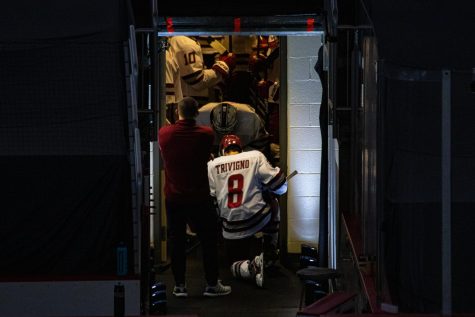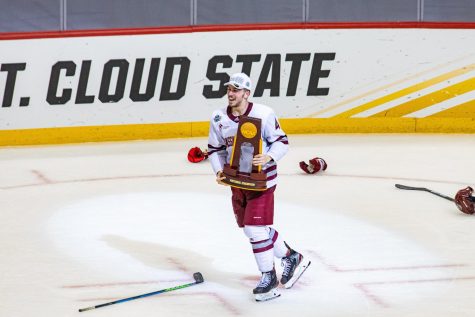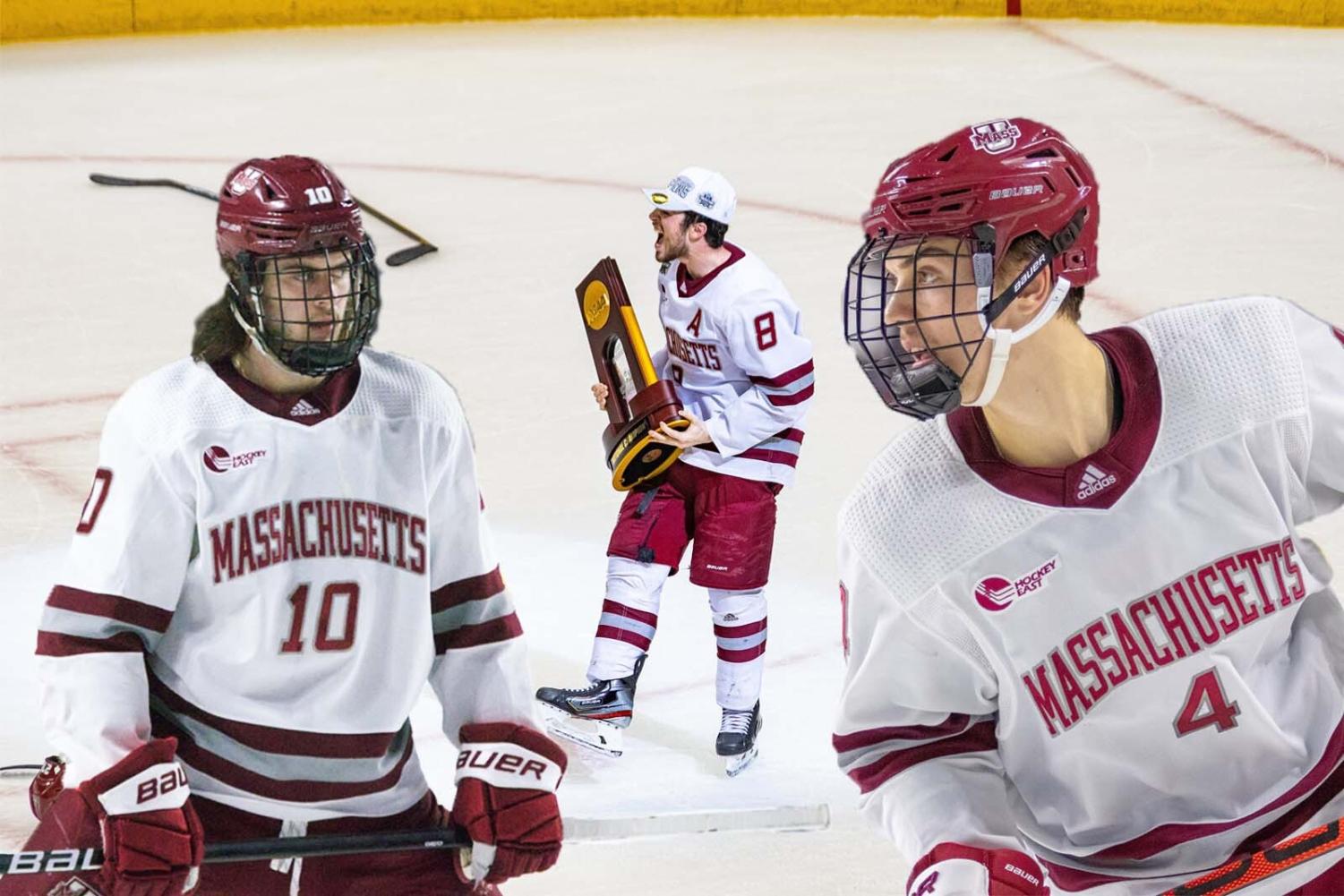‘Nobody really had many expectations for any of them except us,’ how Greg Carvel shapes undrafted Minutemen into NHL prospects
Bobby Trivigno, Josh Lopina and Matthew Kessel use their time in college to make them pro-ready
April 4, 2022
Too small.
Too skinny.
Not developed enough.
Those phrases were used to describe Bobby Trivigno, Matthew Kessel and Josh Lopina at different stages in their young hockey careers. But Massachusetts hockey coach Greg Carvel used different words when assessing the players he saw in front of him.
Good character.
Good hockey sense.
Physical.
In 2022, there aren’t many people within NHL organizations doubting the abilities of Trivigno, Kessel and Lopina. Those three names became synonymous with UMass. They are some of the brightest stars the Minutemen put on the ice, so it was no surprise that after the 2021-22 season ended, the trio of prospects signed entry level NHL deals and made the jump to go pro.
All three are destined to play under the bright lights, on the biggest stage in hockey sooner or later. But before they arrived at UMass, that was far from the case.
***

Bob Trivigno knows exactly why his son Bobby was constantly overlooked early in his career. Junior teams, college coaches and scouts typically liked his play style, but they couldn’t get past the one thing Bobby couldn’t do a whole lot about.
“It was his size,” Bob said.
Bobby was a gifted hockey player in his youth. He was always a top-six forward in youth hockey, but he was also always one of the smallest kids on his team. His play on the ice never dropped off because of it, but his interest by teams did, even as far back as junior and prep school hockey.
Every year, Bobby and his dad went to tournaments all over the country where the budding star could match up against the toughest competition in his age group. He excelled in that environment and being an undersized forward didn’t hinder his goal-scoring ability. But every year at the end of the weekend’s games when it came time for the all-star game, Bobby was left off the list of participants.
Bob told his son not to worry about that. Bobby was better than some of the kids selected to participate, but he needed someone to take a chance on him.
Bobby’s prep school, Shattuck St. Mary’s, didn’t appear it would take that chance on him either.
Despite family ties to the Minnesota school, Bobby didn’t make the cut at Shattuck his first time around, and on his second year of tryouts, coaches placed him on the tier two team. For as expensive and far away from the Trivigno’s hometown that the school was, Bob still wanted Bobby to stick around on the tier two team and prove Shattuck wrong for making that decision.
Once again, Bobby was waiting for someone to take a chance on him.
“A lot of parents, especially in the hockey world, they assess their kids while they’re wearing Wayne Gretzky sunglasses and that’s all they can see is Wayne Gretzky,” Bob said. “And I kept on saying to myself, ‘I’m not wearing my Wayne Gretzky glasses but [Bobby] is pretty freaking good.’”
Bobby became the best tier two player at Shattuck and left the coaching staff no choice but to put him on the top team the following season. They grew to love the play style he brought and even outside of the scoring upside, coaches were starting to take notice of the tenacity and physicality that the five-foot-eight forward brought to the ice. One day after a game, a coach came up to Bob and made a comment that perfectly represented Bobby’s impact on the ice.
“Someone forgot to tell your kid he isn’t six-foot-four.”
Bobby never played like he was undersized; he knocked people around the ice at every level including his four seasons at UMass. He made a name for himself as a pest but developed into one of the best college hockey players in the country.
Junior hockey coaches didn’t see his potential.
College recruiters didn’t see it, either.
NHL scouts didn’t seriously consider him as a draft prospect.
But one coaching staff saw a fire inside Bobby, and they took a chance on him: Greg Carvel, Jared DeMichiel and Ben Barr.
“Bobby is one of the greatest college hockey stories there is because he was the underdog,” Carvel said. “He was the kid that people doubted, and he won every award he possibly could except the Hobey … double-winner of major awards, national champion and two-time Hockey East champion, I don’t know who’s got a resume like that.”
All Bobby needed was that chance, and he made the most of it at UMass. During the very first meeting Carvel had with Bobby and his dad, it was clear that the Minutemen coach had faith in what Bobby could bring to the table. Bob asked Carvel one question that solidified that feeling every person in the room shared.
“I said, ‘[Bobby] wants to play in the NHL … do you think that you can get him ready for the next level?’”
Carvel responded with conviction and without any hesitation.
“Absolutely I can.”
Now, Bobby is in the New York Rangers pipeline, eyeing a roster spot on the NHL team he grew up watching.
***

While Trivigno was lighting up college hockey and making a name for himself at UMass, he was bringing another bright young star along with him.
Josh Lopina.
Lopina was a higher profile prospect than Trivigno and he received his fair share of interest by college coaches. His USHL stats were notable, the center earned 62 points across two seasons in the junior league, but his points per game only averaged out to 0.58. And like Trivigno, but to a lesser extent, scouts had another issue with him that led to him going undrafted out of the USHL: size.
“He was a skinny kid,” Carvel said.
Carvel and his coaching staff saw a lot of positives in Lopina’s game; he was a tall forward with good hockey sense, and they knew that they wanted him in a Minuteman jersey, so they talked him into committing to UMass.
“We thought [Lopina] could develop into something,” Carvel said. “Every time I went to watch him in juniors I said ‘this kid’s going to be really, really good’ … I just liked the way he played the game.”
Since Lopina came to UMass during the COVID-19 impacted season in 2020-21, he wasn’t able to have a normal offseason. Not being on campus for the summer meant missing out on the valuable strength training.
When Lopina did arrive on campus, he hit the ground running. As his first season progressed and he started getting more time in the weight room with the strength coaches, he turned a corner in his development. He added muscle onto his large body frame and became a more dominant threat as a result. It not only allowed him to increase his physicality in the faceoff circle, but also in the offensive zone. Lopina started to live on the crease.
Whether he was screening goaltenders’ eyes, deflecting pucks in front or receiving passes and quickly firing them into the back of the net, Lopina’s net presence became one of UMass’ most valuable offensive assets.
That success put more of a spotlight on Lopina, and by the end of his freshman season he made a name for himself, winning co-Rookie of the Year honors from Hockey East. He went from a player undrafted out of the USHL to an Anaheim Ducks fourth round pick after one season with the Minutemen, and he had an entire second year to continue his development.
The strength kept building, especially once Lopina got to experience a semi-normal offseason. Not only that, but his relationship with Trivigno grew even more. The line mates became best friends and established a strong connection on and off the ice. Trivigno took Lopina under his wing and in their second season together they led one of the best lines in all of college hockey.
“Nobody would have expected Josh Lopina to be Rookie of the Year in Hockey East,” Carvel said. “But he got to play with [Trivigno], and he got to be led by [Trivigno], and he’s the kind of kid that has that consistency and drive, and he fell quickly into what we do here.”
For as much as Trivigno helped Lopina, the growth went both ways. Lopina’s skill helped Trivigno get more offensive touches and score more points. In a lot of ways, the duo helped each other earn NHL contracts, and before they parted ways, Trivigno had high praise for the skill that Lopina brought to the table.
“I don’t know if I’m ever going to have as good of a center as I do in him.”
Lopina will bring those skills to the Anaheim Ducks organization, playing for their AHL affiliate in San Diego.
***

Matthew Kessel was locked into his role as a defensive defenseman in the eyes of many scouts. He had the size and skill inside his own blue line, but not enough upside in the offensive zone for NHL teams to take a chance on drafting him out of the USHL. They wanted to wait and see what Kessel showed in college before making a commitment to the prospect.
“I think they wanted [me] to improve all the way around,” Kessel said.
Getting Kessel to the next level was a testament to his work ethic, but it was also a matter of circumstance.
Kessel was originally committed to Miami Ohio, but an upheaval of the coaches in that program left him searching for a new college to call home. At that same time, Carvel, Barr and DeMichiel were scrambling to find a replacement defenseman for a prospect who left the program during the late summer.
Kessel had a prior relationship with Barr, and everything fell into place at the right time to bring him to UMass.
“He’s probably the reason I’m here, pretty much,” Kessel said of Barr’s influence on his college decision. “He helped me get here because he coached my brother at Western Michigan.”
Carvel never met Kessel before the defenseman arrived on campus. And by the time he did get there the season was only a few weeks away, so expectations for Kessel weren’t set very high. As long as he could hold his own in the defensive end, that would be helpful for the Minutemen backend that was already loaded with talent.
“I don’t think he had ever scored more than two goals in the USHL in a year, so we just thought he was going to be a big, shutdown defenseman, which there’s nothing wrong with those guys,” Carvel said.
“But he quickly turned into a really good two-way defenseman, he’s got a huge shot.”
On top of falling into the right place at UMass, Kessel fell into the right defensive pairing alongside Zac Jones.
The duo meshed instantly. Kessel was the big-bodied, defensive-minded player and Jones was the smaller, highly-skilled offensive talent. What Jones lacked in defense, Kessel was able to make up for and vice versa in the offensive zone.
By their sophomore seasons, Kessel and Jones were the best pairing UMass put on the ice. They played together on the top power play unit, took most of the important offensive shifts at the end of close games and were improving alongside one another. Kessel put up 23 points including 10 goals in that season.
His jump in offense over two seasons with Jones was valuable for UMass as a whole and for Kessel personally. After his freshman season, he was drafted in the fifth round by the St. Louis Blues.
“Playing with Jones, [Kessel] saw offensive creativity and he was a good compliment to [Jones] because he had the size and Jones was learning how to defend,” Carvel said. “That, to me, is equally as important to [Kessel’s] development is who he played with.”
NHL teams came in with questions about Kessel, but he answered those within two years in college. He could have signed an entry level NHL deal after that season like Jones did, but he stuck to the original three-year plan Carvel had in place for him.
“I’m very glad I did that,” Kessel said of his decision to stay a third year. “It’s just [about] taking your time making sure you’re ready for the next step, just continuing your development.”
“I was able to get a lot out of college and develop the whole way, so it was great.”
Now, Kessel can showcase his talent in Springfield for St. Louis’ AHL affiliate, with hopes of making the jump to the NHL for the 2022-23 season.
***
Trivigno, Lopina and Kessel all have different strengths and different play styles, but the trio share one common theme: they all came to UMass undrafted and left with NHL contracts.
And they aren’t the only ones who took that path, either.
Carvel, DeMichiel and Barr have developed a handful of talent and put them in a position to play professional hockey. John Leonard, Mitchell Chaffee, Marc Del Gaizo, Jacob Pritchard and Filip Lindberg all went under the radar during their junior hockey careers but opened the eyes of NHL scouts once they arrived at UMass. Trivigno, Kessel and Lopina saw plenty of prospects take a similar road before them, but they quickly became the three latest success stories in the Minutemen program.
“They were all undrafted, all pretty under the radar,” Carvel said. “Nobody really had many expectations for any of them, except us … all three of them became extremely good offensive players, and I think that’s a trademark of our program.”
“We’re able to get the most offensively out of people.”
One valuable tool Carvel established early on in his head coaching tenure is trust in the people around him. Whether it was DeMichiel, Barr or Matt Lindsay, the assistant coaches provided a great deal of help, particularly in bringing the right people to UMass. Barr was relied on heavily by Carvel before he left the coaching staff, and DeMichiel and Lindsay still are.
“For me to do my job really well and not have to worry about the recruiting part … it’s huge for me,” Carvel said. “I don’t have to spend any time or energy other than when they bring the kid in here and I have to convince the kid that this is where they should want to play. But, I don’t have to get on planes and fly around the country … so it allows me to have more balance in my life and do every other facet of my job better.”
Together with his coaching staff, Carvel is developing a formula for creating NHL talent at UMass.
“We run a program that really challenges and pushes players, but it also provides a system that allows them to be offensive [and] creative,” Carvel said. “Our guys get stronger, they get tougher, they get pushed, and then they play in an aggressive system, and the combination of all that leads to quick development.”
There wasn’t one lucky break or outlier player that allowed so many Minutemen to take such similar paths. Rather, the formula at UMass that builds success not only for a once dying program, but also for the individuals who buy into it.
Carson Gicewicz came to UMass with his graduate year from St. Lawrence and led the Minutemen in goal-scoring on his road to winning a national championship and signing an AHL deal. Del Gaizo and Lindberg both capitalized on strong freshman seasons to get drafted, and signed contracts in three years.
Despite Leonard’s success in high school, a lack of production in the USHL saw scouts begin to worry about the Amherst native’s potential. At UMass he proved any doubters wrong, leading the entire country in scoring during his junior season before signing an entry-level contract with the San Jose Sharks.
“If you’ve got that drive and you’ve got that fire inside of you, what we do here is going to compound that fire and help your development,” Carvel said.
Trivigno, Kessel and Lopina all had that fire, and now they’re taking it to the next stage of their careers. But while they search for success at the professional level, they won’t forget the coaching staff that helped make their dreams a reality.
“They care so much,” Kessel said. “They want the best for everyone, they don’t just want to develop you as a hockey player, they want to develop you as a person as well.”
Colin McCarthy can be reached at [email protected] and followed on Twitter @colinmccarth_DC.
